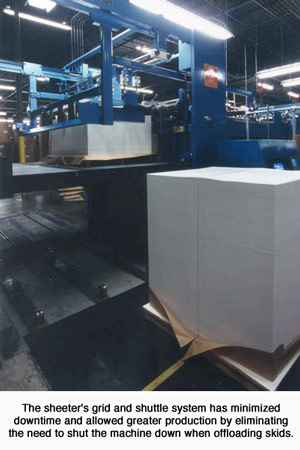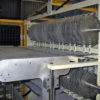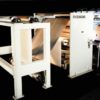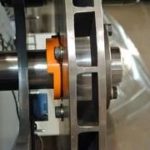Today’s highly competitive business climate makes it necessary for companies to keep quality levels a top priority. Since it was founded 50 years ago, Henley Paper Company, a former High Point, NC based printing paper and industrial packaging and equipment distributor now headquartered in Greensboro NC has put this priority at the heart of their business efforts.
Founded by A.B. Henley, Sr., Henley Paper began by supplying products such as threads, bobbins, and padding and packaging materials to the furniture industry and fine printing paper to commercial printers. After succeeding their father in the late 1970’s, A. Boyden Henley, Jr. and Nick Henley recognized that providing custom sheeting services for commercial printing applications represented an exciting niche for their quality based company. Not only would this new market give them more opportunities, they already had the advantage of being familiar with many aspects of the converting industry.
The Maxson DFK Sheeter at Henley Paper uses composite cylinders to obtain a faster speed curve on shorter cutoffs. Its dual knife rotary design is said to provide better cut quality on heavier knife loads than with conventional stationary bed knife sheeters.
With this in mind, Henley Paper established their Greensboro converting operation, a facility that concentrates solely on first quality paperboard converting. The operation accepts orders through Henley’s five North Carolina branches and one South Carolina branch.
Most of Henley Paper’s sheeting business is for package printers and the occasional folding carton customer. These customers range from companies that produce small point-of-purchase display signs to large corporations with in-house printing capabilities.
The converting division runs paperboard calipers from .008 to .024 board. The majority of work is in small format sizes, with sheet range runs between 25 and 35 in. in length. Although 90% of their product mix is solid bleached sulfate (SBS) board, the company on occasion also runs clay coated, news back, and solid unbleached sulfate (SUS) for milk cartons. Henley’s primary board suppliers are Domtar, Potlatch, and Temple-Inland.
Many of Henley’s printing customers utilize the latest high speed printing presses, and demand sheeted stock of the highest quality. Sheets must be dust free and skids must be well jogged.
The Greensboro facility has been successful in meeting these demands, reports A. B. Henley III. “Quality has been Henley’s strong suit,” he says. “Our investment in the new sheeter sets us even farther apart from our competition.
Wanted: Room for Expansion
 Until recently, the company sheeted material on two older units. While this equipment had served the company well for a number of years, Henley Paper began to find that new business opportunities were being missed due to the limitations of this equipment.
Until recently, the company sheeted material on two older units. While this equipment had served the company well for a number of years, Henley Paper began to find that new business opportunities were being missed due to the limitations of this equipment.
Sheeting capacity was one clear problem. Though Henley was producing the necessary volume of sheeted stock, there was virtually no room for expansion. “We were able to keep up with our current customers’ orders but we couldn’t accept new work,” explains Wayne Deaton, VP of printing papers. “Our older equipment was tying our hands.” Lost business equals missed profits, and Henley needed to resolve this issue in order to continue to expand.
The company also realized that the need to guillotine trim after sheeting was costly. Because its older sheeters featured a stationary bed knife design, a skived edge was often created on heavy calipers, which was unacceptable to their customers, says Deaton. To correct this problem, the sheet had to be trimmed to a finished size, an additional step that was adding labor and waste to the production process.
Turnaround times were a concern as well. Working within a Just-In-Time inventory situation, the company would strive for at least a few days lead times. Increasingly though, a few days needed to be compressed into a few hours.
“Our business was growing, and, to take advantage of that growth we needed to provide quicker service,” notes Henley. “We were missing those opportunities because we weren’t prepared to turn the orders around fast enough.”
The company decided the most logical step toward solving these problems was to invest in a new sheeter. Of overall importance was that the new equipment keep product quality at the highest levels.
A Careful Purchase
Henley Paper purchased the sheeter after careful consideration. The company looked at a number of manufacturers during the evaluation process and finally chose a dual knife rotary (DFK) sheeter from Maxson Automatic Machinery.
“We chose Maxson for several reasons,” says Deaton, “but the most important consideration was its ability to deliver the speed we were looking for without sacrificing our quality requirements.”
A number of features on the DFK allowed it to meet Henley’s demands. The sheeter utilizes composite cylinders to obtain a faster speed curve on shorter cutoffs.
In Henley Paper’s case, this provides an important advantage. The DFK Sheeter runs at speeds of up to 1,300 fpm and has a cyclic velocity drive, which maintains a sheet length accuracy of ±0.015 inches regardless of cutoff length or line speed.
This ability to produce press-ready sheets quickly and accurately was of major importance to the company. The sheeter’s accuracy and ability to sheet without a skived edge have virtually eliminated the need to guillotine trim, says Deaton.
He adds, “The only time we do any trimming now is when someone requires a length shorter than the sheeter will take. Now we’re using the trimmer for what it is intended for, because the sheeter is doing its job.
A specially designed cross cutting knife system that features synchronized dual rotary knives reportedly eliminates the need for manual adjustments for squareness. “We’ve found that the dual rotary knife design provides better cut quality on heavier knife loads than with conventional stationary knife sheeters, : says Deaton. “For customers, this results in a straight, clean, square cut.”
Another feature designed to help Henley keep quality high is the PEN-MAM Dust Collector, which cleans the top and bottom of the packet being sheeted without contacting the sheets. With the dust collector in operation, the company has seen no dust problems at all. “The dust collector is a precaution rather than a need,” Deaton says. “Dust can cause a world of problems for the printer. If there is dust on the edge of the sheet, when it goes through the printing press, the ink will pull that dust in from the sides. The dust is then picked up by the rollers, creating hickeys. Obviously, printers don’t like that one bit!”
The sheeter’s automated tension control system also works to minimize sheet defects. A decurl unit reportedly ensures a flat sheet even on heavy calipers, and a dancer roll within the unit absorbs web fluctuations encountered when sheeting egg-shaped rolls. This maintains the proper web tension for an accurate cut. “Occasionally we would have a problem with out-of-shape rolls. The dancer roll takes care of that.” Deaton says.
And since the tension control system is automated and can be monitored from either the rear of the machine or the front, Deaton says operators are able to handle their jobs and take greater care in examining the web rolls without having to move around the machine so much”, explains sheeter operator D. H. Morrison.
In order to increase productivity, the sheeter features two shaftless roll stands that give the ability to sheet two webs side-by-side or superimposed. This effectively decreases downtime and optimizes efficiency during roll changes by eliminating the need for an overhead hoist when loading rolls, Deaton explains.
Instead, the operator simply moves the roll into place, with the roll stand completing the loading by cradling the roll, chucking it, and lifting it into position. “It used to take us about 20 minutes to change a set of rolls,” says Morrison. “Now, we’re looking at 3 to 4 minutes.”
The sheeter is also equipped with an airfoil overlap system and an extending grid and shuttle system. The airfoil overlap is designed to allow higher speeds when running lighter caliper material, says Deaton. And as the sheeted material moves into the stacking station, the extending grid and shuttle system allow the machine to keep running while skids are off loaded.
“When a skid reaches full capacity, the extending grid is utilized to temporarily hold the sheets to provide continuous stacking”, explains sheeter operator Ernest Phelps. “The shuttle then automatically moves the full skid out of the stacking area and to the side so that we can unload it. All that’s left to do is drop an empty pallet into place and reset the extending grid to continue stacking.”
Ready for Takeoff
What all of the features have meant to Henley Paper is an increase in sheeting capacity and a decrease in turnaround times while still focusing on the ever important issue of quality.
According to Morrison and Phelps: “This machine is twice as fast as the two older machines put together. Not only have we been able to drastically improve turnaround times for our current customers, but we’ve been able to pick up new business that previously, because of turnaround times, we would have to decline.
The addition of the grid and shuttle system has minimized downtime, allowing greater production off the machine and the occasional hourly service. “I’ve had customers call in desperate need, and we’ve gotten a job out to them within an hour,” reports Deaton. “Before, that same job could have taken us all day, and, essentially we would have lost the work to someone who was faster.
Now that production has increased and waste has been reduced, Henley Paper is on track to increase their customer base. In addition to providing its current customers with the same superior product in less time, the company hopes to move into other markets, both in its home state of North Carolina and beyond.
Henley sums it all up by saying, “For superior quality and quick turnaround, this sheeter has significantly raised the bar for our competition.”
Reprinted from Paper Film Foil Converter, August 1997






